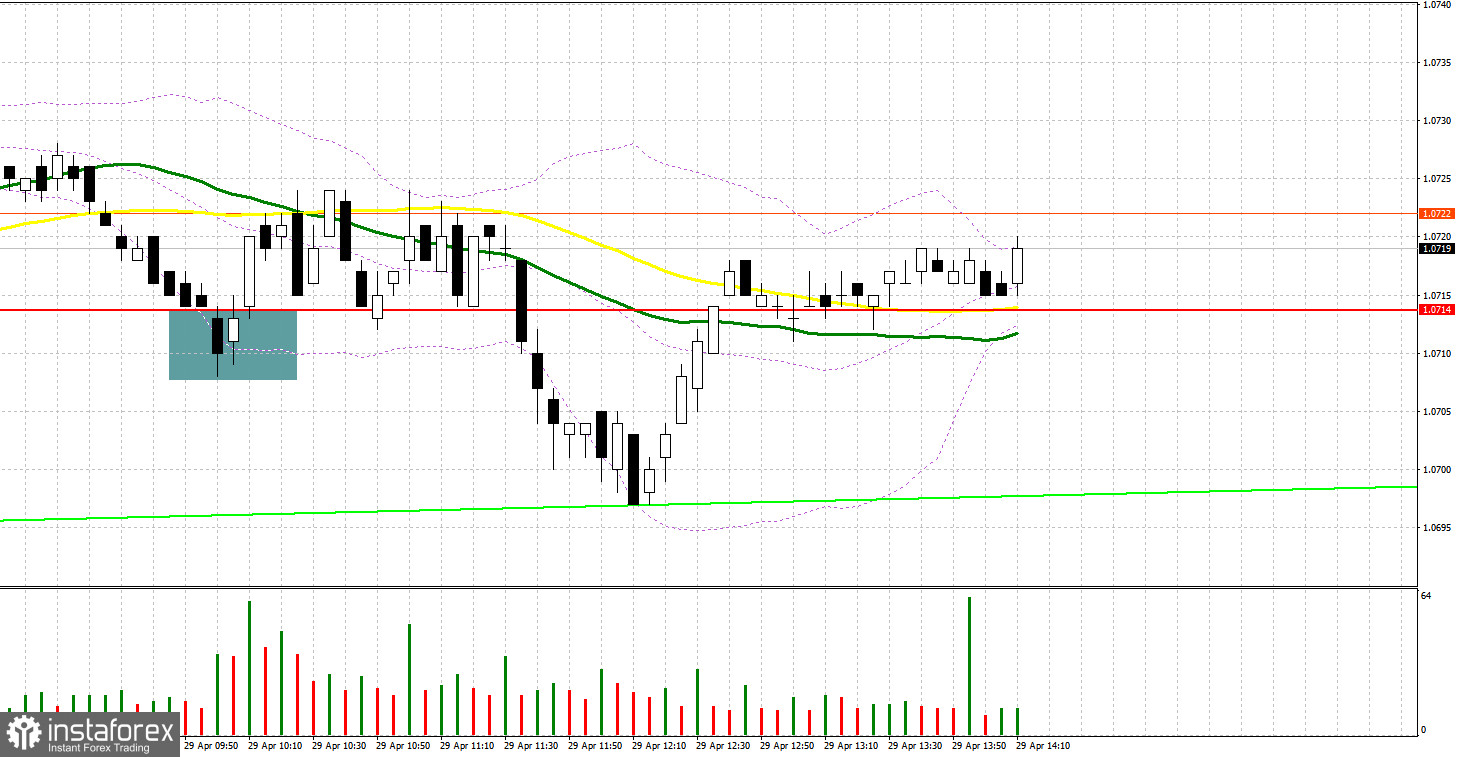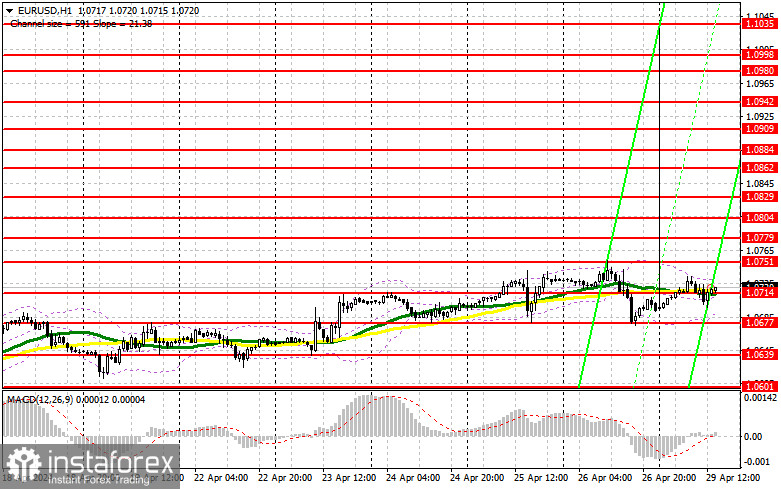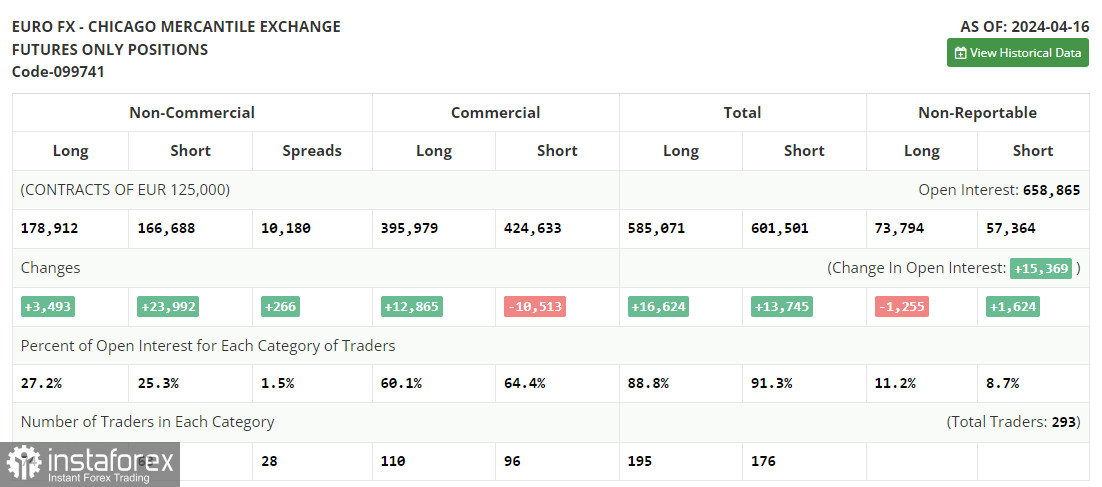In my morning forecast, I focused on the level of 1.0714 and planned to make decisions on market entry based on it. Let's take a look at the 5-minute chart and figure out what happened there. The decline and the formation of a false breakout led to a signal to buy the euro, but the pair did not see significant growth. Trading continued around the level of 1.0714, so I decided to exit the market and wait for new signals. In the second half of the day, the technical picture remained unchanged.

To open long positions on EUR/USD, the following is required:
Considering that besides inflation data in Germany, we have nothing else today to rely on for euro sellers. For this reason, I will continue to look for suitable entry points into the market, relying on technical levels. However, please note that 1.0714 now serves only as a reference point for profit-taking, as this area was quite strongly "smudged" in the first half of the day. It is best to wait for a decline and the formation of a false breakout around the larger support area of 1.0677, formed as a result of last Friday's trading. Only such a scenario will provide an entry point for long positions capable of pushing the euro towards the major resistance level of 1.0751, also formed last week. Breaking and updating this range from top to bottom will lead to the formation of a new bullish market and a buying signal with a chance of a surge to 1.0779. The ultimate target will be the maximum of 1.0804, where I will take a profit. In the case of a decline in EUR/USD and the absence of activity around 1.0677, which is unlikely due to the lack of US statistics, pressure on the euro within the medium-term bearish trend will return. In this case, I will only enter the market after the formation of a false breakout around the next support level of 1.0639. I plan to open long positions immediately on the rebound from 1.0601 with a target of a 30-35 point upward correction within the day.
To open short positions on EUR/USD, the following is required:
Euro sellers have every chance of pushing the pair down, but for this, I would like to see a test of the larger resistance level of 1.0751. The formation of a false breakout would be an excellent scenario for entering short positions with the goal of a decline to around 1.0717, where the moving averages, playing on the side of buyers, intersect. Breaking and consolidating below this range, along with a reverse test from bottom to top, will provide another selling point with the pair moving towards 1.0677. There, I expect more active involvement from large buyers. The ultimate target will be the minimum of 1.0639, where I will take a profit. In the event of an upward movement of EUR/USD in the second half of the day, as well as the absence of bears at 1.0751, the bears will bid farewell to their hopes of regaining control of the market already at the beginning of this week. In this case, I will postpone selling until the test of the next resistance at 1.0779. I will also sell there, but only after an unsuccessful consolidation. I plan to open short positions immediately on the rebound from 1.0804, with a target of a 30-35 point downward correction.


Indicator signals:
Moving averages
Trading is conducted around the 30 and 50-day moving averages, indicating a sideways market.
Note: The period and prices of moving averages considered by the author are on the hourly chart H1 and differ from the general definition of classical daily moving averages on the daily chart D1.
Bollinger Bands
In the event of a decline, the lower boundary of the indicator around 1.0677 will act as support.
Description of indicators
- Moving average (determines the current trend by smoothing volatility and noise). Period 50. Marked in yellow on the chart.
- Moving average (determines the current trend by smoothing volatility and noise). Period 30. Marked in green on the chart.
- MACD indicator (Moving Average Convergence/Divergence). Fast EMA period 12. Slow EMA period 26. SMA period 9.
- Bollinger Bands. Period 20.
- Non-commercial traders - speculators such as individual traders, hedge funds, and large institutions using the futures market for speculative purposes and meeting certain requirements.
- Long non-commercial positions represent the total long open position of non-commercial traders.
- Short non-commercial positions represent the total short open position of non-commercial traders.
- The total non-commercial net position is the difference between the short and long positions of non-commercial traders.
 English
English 
 Русский
Русский Bahasa Indonesia
Bahasa Indonesia Bahasa Malay
Bahasa Malay ไทย
ไทย Español
Español Deutsch
Deutsch Български
Български Français
Français Tiếng Việt
Tiếng Việt 中文
中文 বাংলা
বাংলা हिन्दी
हिन्दी Čeština
Čeština Українська
Українська Română
Română

